NDVI stands for "Normalized Difference Vegetation Index". NRG stands for "Near-infrared / Red / Green". NDVI and NRG are both ways to visualize the amounts of infrared and other wavelengths of light reflected from vegetation. Because both these methods compare ratios of blue and red light absorbed versus green and IR light reflected, they can be used to evaluate the health of vegetation. It's a snapshot of how much photosynthesis is happening. This is helpful in assessing vegetative health or stress. (Read more here: https://www.agronomy.org/publications/jeq/articles/36/3/832) ## Do-It-Yourself These techniques for vegetation analysis were developed for satellite imagery, but at Public Lab, we've been working a lot on capturing infrared imagery using our DIY [near-infrared camera](/wiki/near-infrared-camera) setup, and combining it with visible bands to produce NDVI images such as the one above. ## What these images mean What exactly are these images we're trying to make? What do they tell us about vegetation, and why? These diagrams should help to understand what it is we're doing and why these are good ways to analyze plant life. ## The NDVI equation [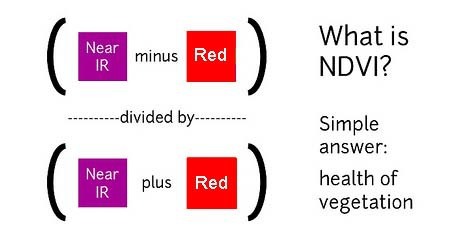](/i/44723) **NDVI = (Near Infrared - Red)/(Near Infrared + Red)** NDVI is a ratio which tries to emphasize photosynthesis while filtering out sun glare. The above equation is run for every pixel, using source data from an infrared photo and a visible light photo, like this pair: [](https://publiclab.org/system/images/photos/000/021/771/original/5390895115_c9d4d38fec_o.jpg) The result can be false-colored to make the high-photosynthesis areas more clear, and used to examine where plants are and how healthy they are. [](https://publiclab.org/system/images/photos/000/021/770/original/PetVISNDVIcomp.png) _Figure above: Normal color photo (right) and normalized difference vegetation index (NDVI) image (left). NDVI image was derived from two color channels in a single photo taken with a camera modified with a special infrared filter. Note that tree trunks, brown grass, and rocks have very low NDVI values because they are not photosynthetic. Healthy plants typically have NDVI values between 0.1 and 0.9. -- @cfastie_ ### Activities Here are a range of activities you can do to produce and interpret your own NDVI imagery, whether downloaded from a satellite imagery provider or [collected yourself using a DIY technique](/wiki/multispectral-imaging) [activities:ndvi] ****   Most DIY converted cameras today (those from Public Lab) use RGN instead of NRG, so the blue channel represents infrared instead of the red channel. That looks like this: [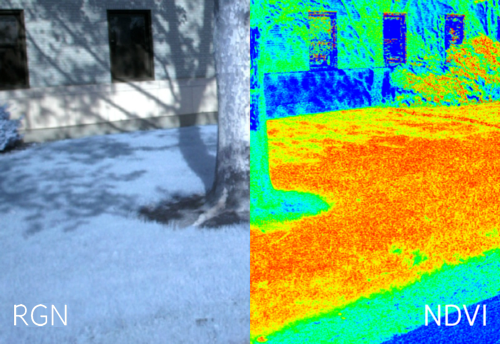](/i/45468?s=o) **** ## NRG imagery Some people are also interested in producing NRG imagery (like the below image), where `Near-Infrared, Red, and Green` are used to compose a picture instead of the usual `Red, Green, and Blue`. [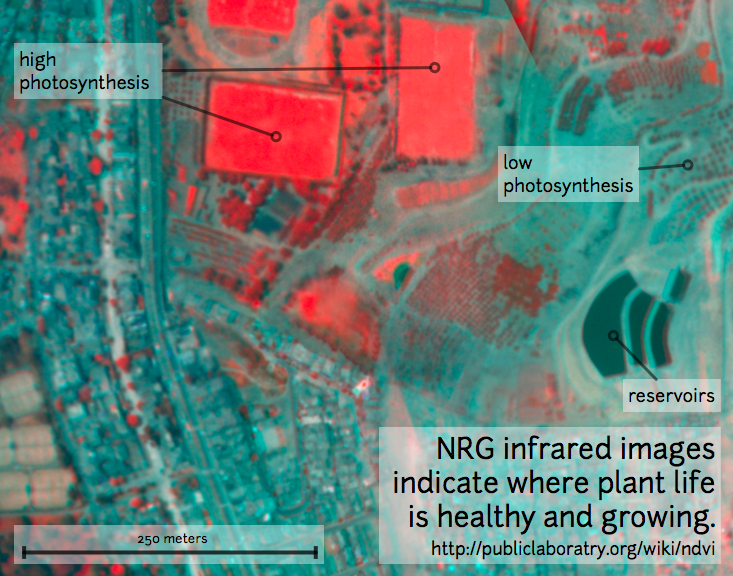](/i/25064) This diagram explains the swapping, which allows us to 'see' infrared as if it were a normal color: [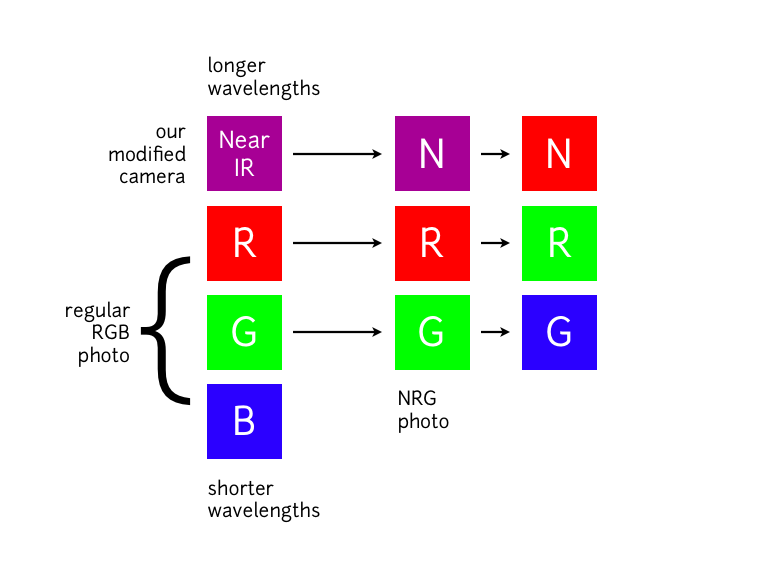](/i/25063) **In NRG images, the deeper and clearer the red color, the denser and healthier the vegetation (more or less).** ### Questions [questions:ndvi] ### Other examples of DIY NDVI imaging From around the internet: Begin watching at 2 minutes to see the resulting imagery: *This topic is part of the [Grassroots Mapping Curriculum](/wiki/mapping-curriculum) series.* **** [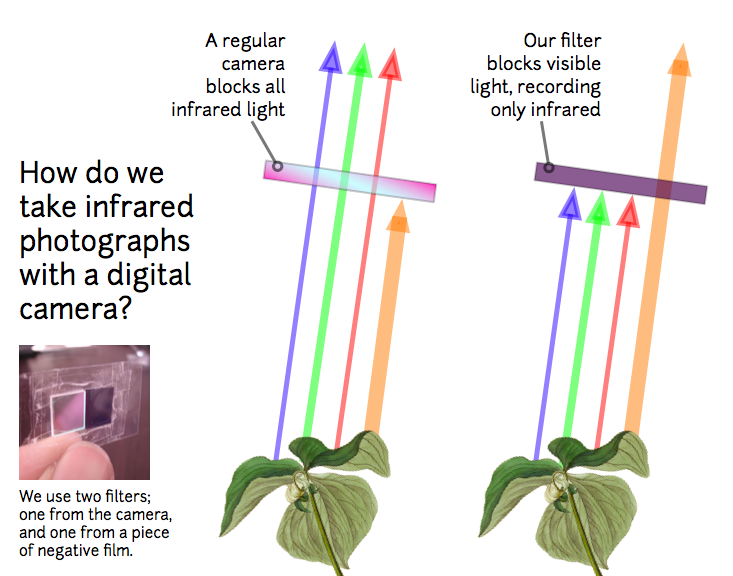](/i/25066) [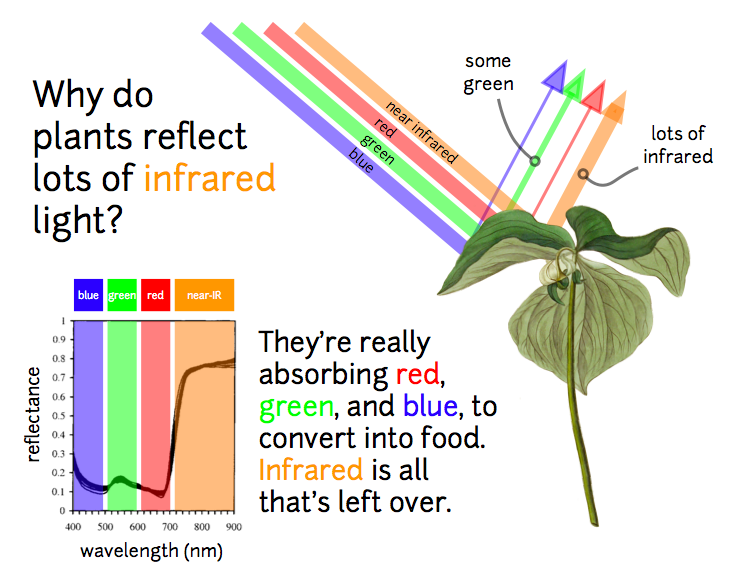](/i/25065) ...
| Author | Comment | Last activity | Moderation | ||
|---|---|---|---|---|---|
| warren | "These are some good questions. We started to abandon basic HSV because it "wraps around" -- high values and low values are both "red" -- but if you..." | Read more » | over 9 years ago | |||
| nedhorning | "Hi - I actually thought I posted this a few days ago but for some reason I guess it didn't work. Now when I post it I see that the comments are int..." | Read more » | over 9 years ago | |||
| geraldmc | "Very helpful Ned, thanks! I'd also appreciate seeing your R script. " | Read more » | over 9 years ago | |||
| RQ-05 | "Is it possible to put a LUTs for the HDV? I did a few images that came out great using the HDV, and I would like to put a scale on them. Maybe I mi..." | Read more » | over 9 years ago | |||
| Tbtouaki | "Hi I had wrong white balance for my camera. Thanks everyone for the help. Sorry for the trouble If anyone has any idea on how to save pictures take..." | Read more » | over 9 years ago | |||
| cfastie | "Yes, those photos are good. Ideal photos have some live plants, maybe some recently dead leaves, and some things that are not foliage. Outdoor phot..." | Read more » | over 9 years ago | |||
| cfastie | "Sorry, I don't remember the details of this process. NDVI should range from -1 to +1. Blue should be the lowest values, and red the highest. So fro..." | Read more » | over 9 years ago | |||
| warren | "I'd love to see the R script. How do you recommend people select a value for redGamma or percentBlue? " | Read more » | over 9 years ago | |||
| nedhorning | "Hi Jeff - I'm not sure what math you are looking for. For the gamma correction I use: The first step is to remove the effect of the gamma correcti..." | Read more » | over 9 years ago | |||
| warren | "Specifically, I think we need to encourage people to structure experiments around what these cameras do best at the moment -- comparisons between v..." | Read more » | over 9 years ago | |||
| cfastie | "I think you're right that subjective is the wrong word. Maybe qualitative. A plant with an actual NDVI value of 0.5 may have an infragram NDVI valu..." | Read more » | over 9 years ago | |||
| jmlong | "Could you specify the color scale used, i.e. what was the number range that spanned from blue to red? " | Read more » | over 9 years ago | |||
| warren | "Hi, Chris - I've been plugged into several other projects and really didn't have time to do this properly, and there was some confusion over the we..." | Read more » | over 9 years ago | |||
| warren | "Hi Ned - this is great. If you post the math, I'll try to port it to Infragram as well. Great work! " | Read more » | over 9 years ago | |||
| nedhorning | "Chris - Thanks for pointing that out. I typically clip the values so anything greater than 1 becomes 1 and anything less than -1 become -1. " | Read more » | over 9 years ago | |||
| cfastie | "It looks like the computed index will no longer be between -1 and +1 if you adjust the red value that way. Do you then have to rescale the index so..." | Read more » | over 9 years ago | |||
| nedhorning | "Hi Agustin - Your second equation is one option. Another is: (blue- (red-blue0.8)) /(blue+(red-blue0.8)) You can play around with the factor I add..." | Read more » | over 9 years ago | |||
| agustin_castellano | "Sorry is should be (blue- (red-blue)) /(blue+(red-blue)) ?? To extract the nir data in the red chanel. Regards. " | Read more » | over 9 years ago | |||
| agustin_castellano | "Could something like this (blue- (red-blue)) /(blue-(red-blue)) ?? To extract the nir data in the red chanel. Regards. " | Read more » | over 9 years ago | |||
| nedhorning | "Hi Agustin, The formula you wrote is what I use. I typically use the PhotoMonitoring plugin which can be found here: https://github.com/nedhorning..." | Read more » | over 9 years ago | |||
| agustin_castellano | "Hi Ned thanks for your research! Is great this information. i have two doubts. First if i use a red filter how should be the formula (blue - red) ..." | Read more » | over 9 years ago | |||
| agustin_castellano | "Hi Andresc4, i would like be in touch with you.i'm researching about the same like you. I live in Argentina. Please contact me my emailagustin.cast..." | Read more » | over 9 years ago | |||
| agustin_castellano | "Hi Andresc4, i would like be in touch with you.i'm researching about the same like you. I live in Argentina. Please contact me my email agustin.cas..." | Read more » | over 9 years ago | |||
| mathew | "@Jimsford. you gotta print one! Shapeways could run one for you. " | Read more » | over 9 years ago |